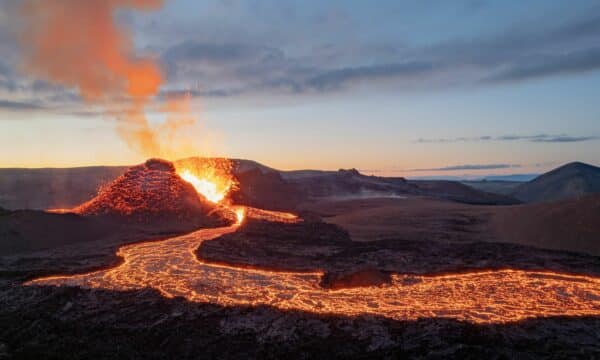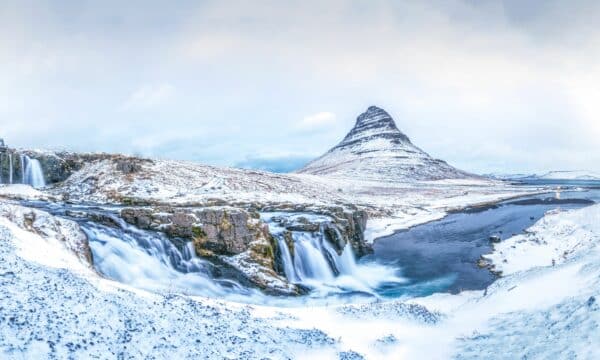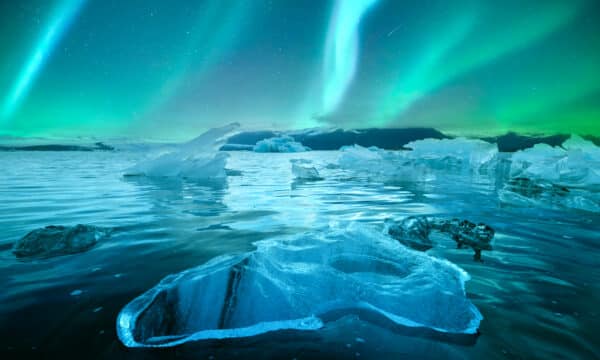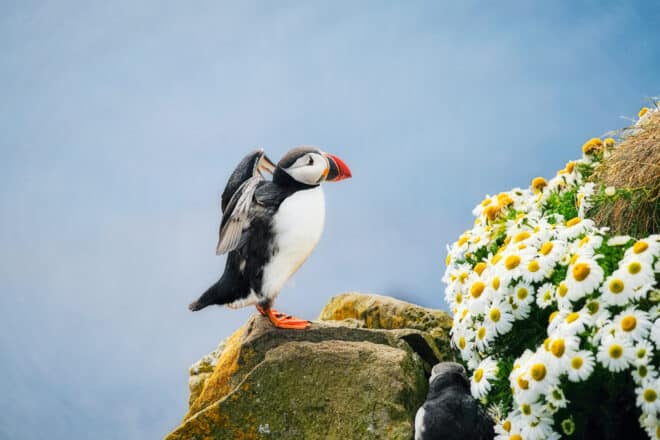
Summer in Iceland is characterised by cool days and sunshine that extends late into the night. June, July, and August are considered the summer months though you could find the same cool days and bright nights in late May and early September.
Summer is the high season in Iceland, and though the most popular tourist attraction might be busier than in the winter, finding tranquillity and solitude is easy.
Summer Weather in Iceland
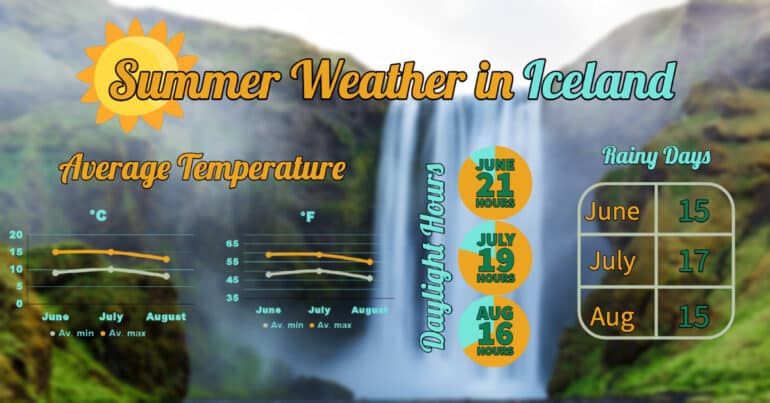
Temperatures are mild in Iceland in the summer, with an average temperature of 9-15°C in June (48-59°F), 10-15°C in July (50-59°F), and 8-13°C (46-55°F) in August. Of course, these numbers differ between regions, with the North and East often experiencing higher temperatures than the South and West.
Occasionally, you’ll see the temperature reach over 20°C (68°F) in the summer, sometimes up to 25°C (77°F). When that happens, expect to see half of the population outside turning pink while soaking up every ray of sunshine. Though the temperature might be pleasant, often it is accompanied by rain. June and August see, on average, 15 rainy days, while July has 17.
Midnight Sun in Iceland
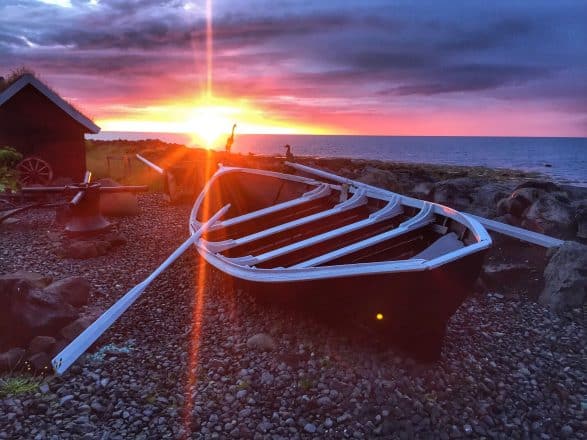
The Midnight Sun is a phenomenon north of the Arctic Circle and south of the Antarctic Circle, where the sun does not dip below the horizon at night. As Iceland sits just below the Arctic Circle, it experiences a little of the Midnight Sun phenomenon. Though the sun sets, its rays continue to illuminate the sky throughout the night.
The Midnight Sun in Iceland begins in May and peaks on the summer solstice between June 20th – 22nd. On average, Iceland experiences around 21 hours of daylight in June.
The nights stay bright throughout July, with 19 hours of daylight on average. However, darkness gradually takes over in August, when Iceland sees around 16 hours of light.
How to Pack for Summer in Iceland
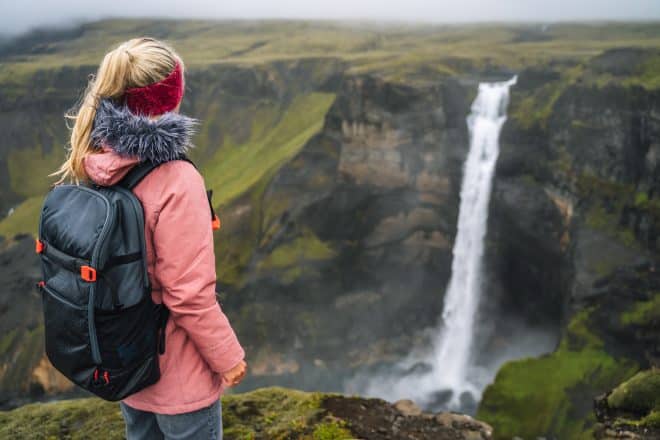
Packing for winter in Iceland seems straightforward enough: just pack the warmest items you own. It is, after all, Iceland. But what should you do in the summer? Does the same rule apply?
Not quite. As mentioned, average temperatures in Iceland range from 8-15°C (46-59°F) and can reach up to 25°C (77°F) in the summer. So you might not need that thick winter coat, but you should bring a warm jumper.
The key to packing for Iceland is layers. Wear a base layer of long or short sleeve t-shirts and add a warm jumper on top, preferably fleece or wool. On top of that, add a lightweight wind and waterproof jacket. This way, you can always take off a layer if the sun decides to grace us with her presence.
You should also bring wind and waterproof trousers in case you want to walk behind a waterfall such as Seljalandsfoss. Also, make sure you wear good waterproof shoes that are comfortable enough for a hike or, at least, walking on uneven ground. A warm hat, scarf, and gloves are also a must in the summer; it can get windy.
Other essentials include a camera, a phone adapter, and a sleep mask for those bright nights. And whatever you do, don’t forget your swimsuit! Around the country are so many hot springs, geothermal pools, spas, and hot tubs, and you are sure to want to take a dip in at least one.
Summer vs. Winter in Iceland
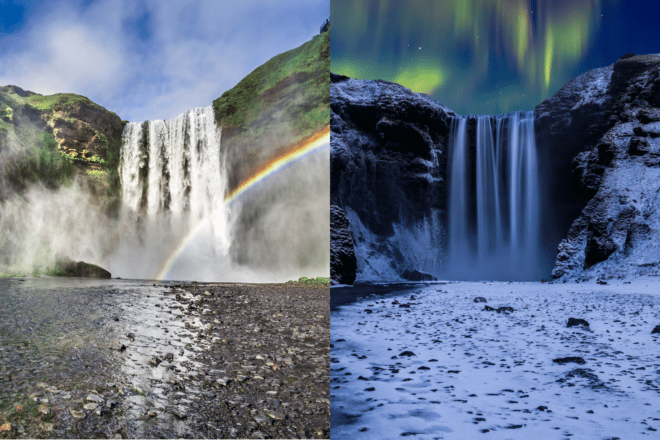
Visiting Iceland at any time of the year is always exciting. But visiting in the summer opens the opportunity to travel further and explore hard-to-reach destinations such as the Highlands or the Westfjords.
The weather in Iceland is generally much colder than in mainland Europe, providing a fantastic alternative for those who like to stay cool during the summer. However, winter visitors might find the cold quite challenging.
Summers are also the perfect time for first-time visitors to Iceland. The cold temperatures of winter are ages away, and the Midnight Sun allows visitors to explore late into the night. You can easily avoid crowds by visiting the most popular attractions late at night.
Can You See the Northern Lights During the Summer in Iceland?
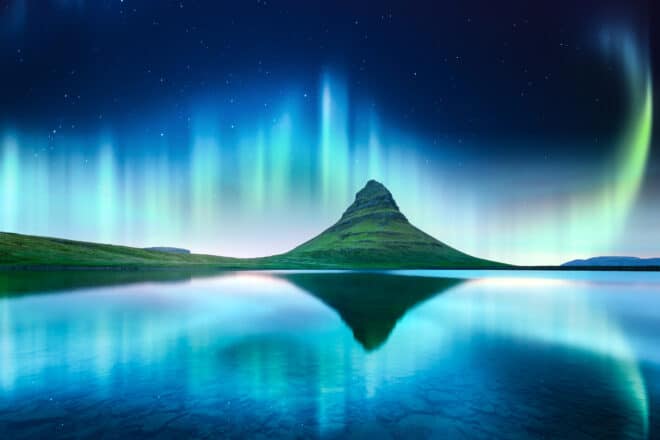
Unfortunately, you can’t see the Northern Lights in June and July in Iceland. This is because the Northern Lights need total darkness so you can see them, and Iceland has very little of that in the summer months, thanks to the Midnight Sun.
However, as August rolls around, so does the dark night sky. Therefore, those visiting in late August have the chance to see the beautiful Auroras.
Summer in Iceland — How to enjoy it?
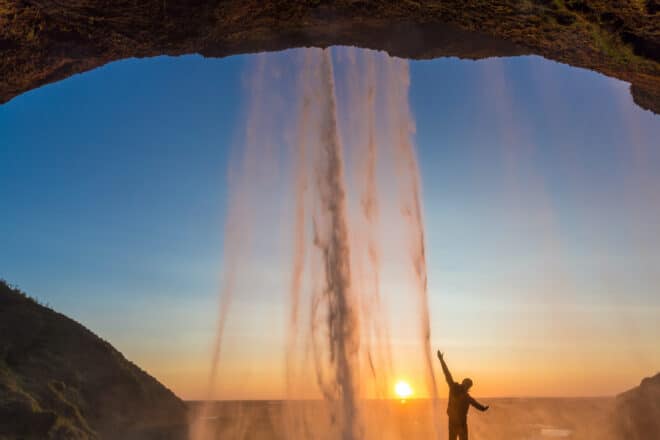
Perhaps the best way to experience Iceland in the summer is on a self-drive tour. Driving around yourself gives you the freedom and flexibility to organise your day as you see fit since no tour guide is rushing you from place to place. If you’d like to explore a waterfall longer, there is nothing stopping you (and you can have a bathroom break whenever you want).
When you book a self-drive tour from Traveo, you’ll get a custom itinerary with information about the places on your route. You decide where to stop, but the itinerary will tell you about attractions, events, and places to eat. It’s like having your very own tour guide on your phone.
Of course, Traveo also offers plenty of guided tours for those who prefer not to drive, both small group and private tours. The latter option is perfect for those who like the benefits of a professional guide as well as the freedom of a self-drive tour.
10 Best Things to do in Iceland in the Summer
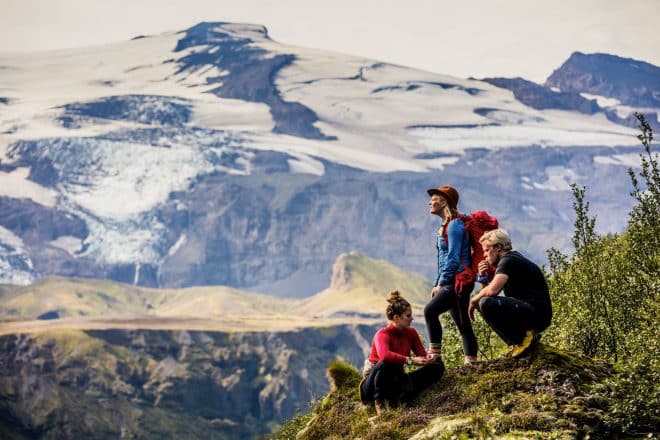
Deciding what to do in Iceland is not an easy task. There are countless attractions, activities, and events competing for your attention.
But that’s why we are here! Traveo’s local travel experts are sitting in front of their computers right now, just waiting to help you plan your dream holiday. Don’t hesitate to contact them for some advice or even a free custom itinerary.
If you need more inspiration, check out my list below of my favourite things to do in the summer in Iceland:
Visiting the Highlands of Iceland
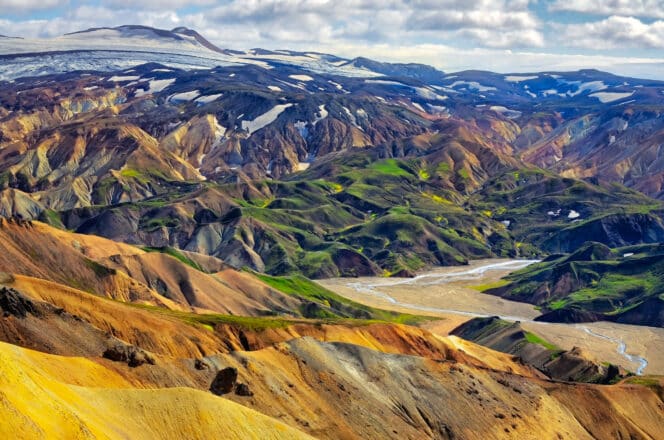
The Highlands of Iceland are the largest uninhabited region of Europe and cover the majority of the country, over 40,000 km² (15,445 mi²). This vast, unspoiled expanse encompasses some of Iceland’s most impressive features yet remains one of the least visited places in the country. That is because it is almost entirely inaccessible for most of the year.
The roads to the Highlands remain closed throughout the winter and spring, usually opening up in June or July. This means that visiting the Highlands is a privilege reserved only for summer visitors.
Majestic glaciers, ancient craters, tall mountains, and a massive lava field characterise the Icelandic Highlands. Amongst this barren landscape lie some of the country’s most beautiful regions, such as Þórsmörk Valley, Landmannalaugar geothermal area, and Kerlingarfjöll mountains.
Exploring the Westfjords
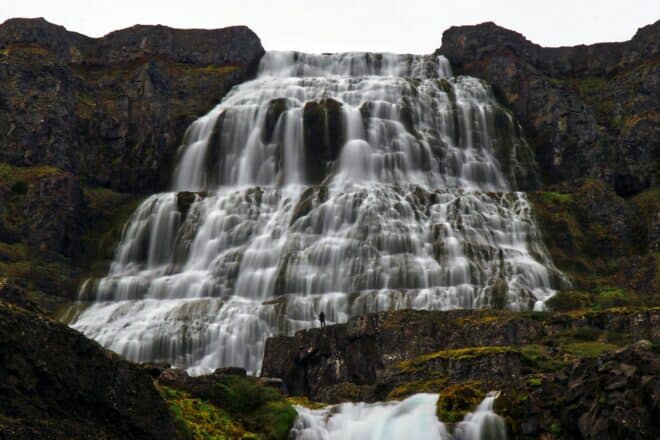
Though the Westfjords are not as inaccessible as the Highlands in the winter, the snowy mountain roads make it difficult for drivers to travel the region. In the summer, however, the roads clear, opening up several routes to this beautiful but scarcely populated area.
Because of their inaccessibility in winter and distance from Reykjavík, the Westfjords are considered somewhat of a hidden gem. And there are plenty of stunning attractions on this 22,200 km² (8,600 mi²) stretch of land just waiting to be explored.
The most famous feature is perhaps Dynjandi, a 100-metre (330 ft) vail-shaped waterfall. A short drive from Dynjandi is Látrabjarg bird cliff, one of the best places in the country to spot puffins in the summer. Rauðasandur Beach is a great place to spend a sunny afternoon, and there are several natural hot springs in the region if you want to take a dip.
Go Puffin Watching
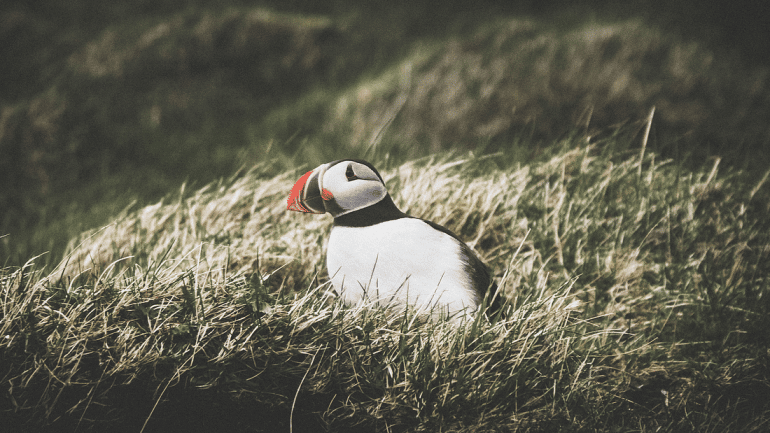
You can’t really talk about summer in Iceland without mentioning our most famous summer visitors: The puffins! This adorable little bird has become the unofficial mascot of Iceland, and not without reason. Over 60% of the world’s Atlantic puffin population resides here between April and September.
There are several places in the country where you can see these colourful creatures. The top ones include:
- Westman Islands off the coast of South Iceland
- Látrabjarg Cliffs in the Westfjords
- Dyrhólaey Promontory in South Iceland
- Borgarfjörður Eystri Town in East Iceland
- Flatey Island in West Iceland
- Grímsey Island in North Iceland
- Lundey Island off the coast of Reykjavík
The easiest way to spot puffins in Iceland is on a guided wildlife tour. And the most fun way is undoubtedly a Puffin and Whale Watching Tour, where you’ll not only look for the adorable little birds but also the gentle giants of the ocean.
Discovering Flatey Island
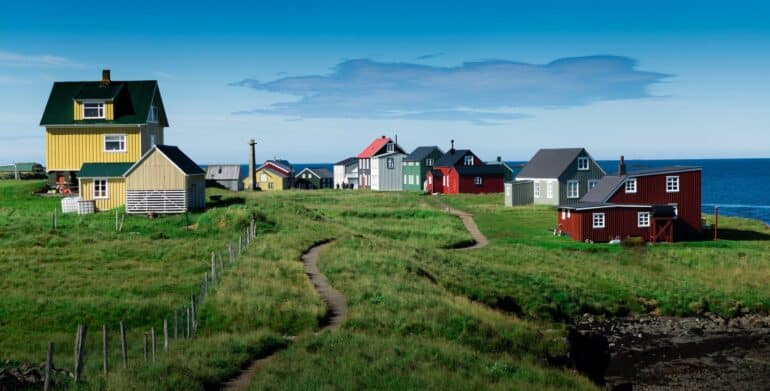
Another one of Iceland’s hidden gems that is mostly inaccessible in the winter is Flatey Island. Located on Breiðafjörður Bay, between the Snæfellsnes Peninsula and the Westfjord, this little island is home to only 10 people year-round.
Though more people inhabit the island in the summer, it is still a fantastic place for those looking for solitude and raw nature. There are only a handful of houses on the island, so the wildlife here reigns supreme. For example, if you step off the only street on the island, know you might get attacked by an Arctic Tern.
Relaxing at Nauthólsvík Geothermal Beach
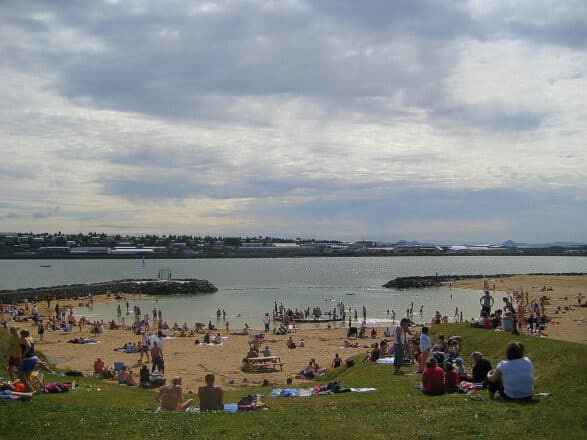
When thinking of Iceland, the image of relaxing on a towel, building sandcastles of golden sand, and taking a dip in a warm ocean seldom pops up. Instead, Iceland’s beaches are more known for being made of black volcanic sands and often accompanied by dangerous ocean waves. However, that is not the case at Reykjavík’s Nauthólsvík Beach.
Nauthólsvík is a man-made geothermal beach, located near Öskjuhlíð Hill and Perlan Museum in Reykjavík. It offers guests heated seawater of 15-19°C (59-66°F), a beach volleyball court, a public-use BBQ, and an ice cream shop; everything you need for a fun beach day.
Summer Festivals in Iceland
You can find festivals in Iceland all year round, but the summer sees the biggest and best. There are a few public holidays celebrated around the country in the summer, as well as smaller town fairs.
The summer even starts with a public holiday: The First Day of Summer. Technically it takes place in spring, in late April, but it marks the end of winter and symbolises brighter days ahead.
Other summer holidays include Iceland’s National Day on the 17th of June, Culture Night at the end of August, and Verslunarmannahelgi. The last one takes place on the first Monday in August, and the weekend before that is one of the biggest travel weekends of the year. Towns around the country hold music festivals, the biggest being in the Westman Islands.
Taking a Boat Tour on Jökulsárlón Glacier Lagoon
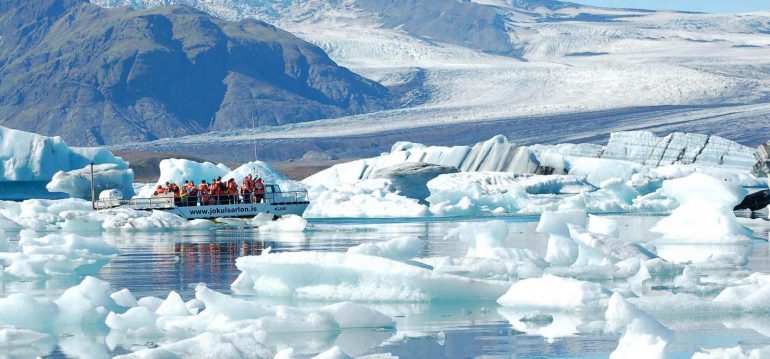
Jökulsárlón is a beautiful lagoon in Vatnajökull National Park, filled with icebergs that have broken off a nearby glacier. You can visit Jökulsárlón year-round, but the summer offers you the chance to see the lagoon’s icebergs up close.
Several boat tours operate on the lagoon in the summer. There are two main types: a swift Zodiac boat tour and a slower amphibian boat tour. The former easily zigzags between the bergs, allowing you to get much closer to them than on the amphibious boat. However, the slow speed of the latter is perfect for photographers and families of small children.
Horse Riding in the Summer
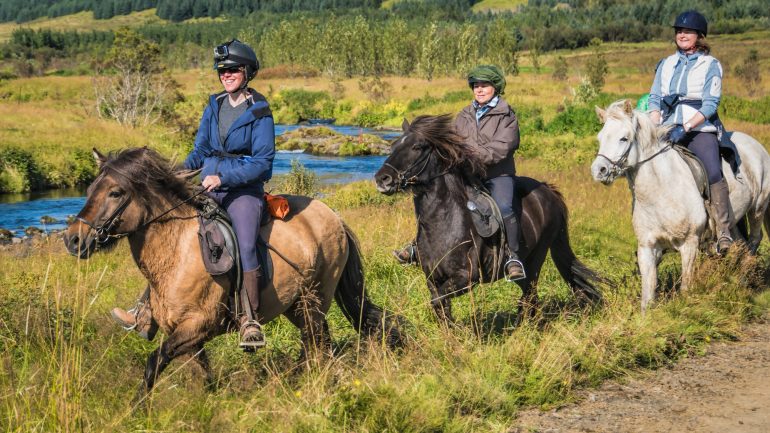
Icelandic horses are a unique breed known for their calm temperament and intelligence. Though you can go horseback riding year-round, exploring the beautiful countryside on the back of a horse in the summer is an experience unlike any other.
The summer also offers the possibility of multi-day horseback riding tours, where you’ll ride into the wild with a local guide.
Summer Hiking in Iceland
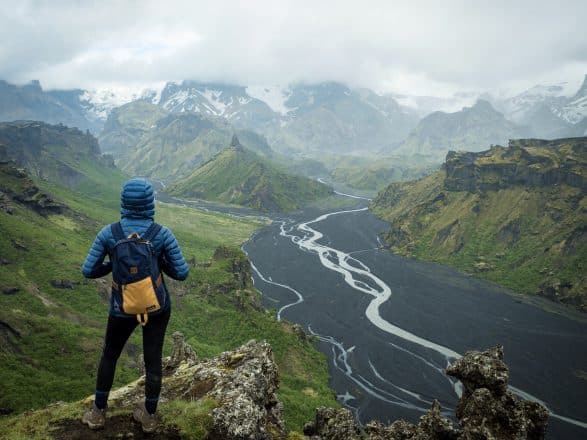
As mentioned before, the beautiful Highlands become accessible in the summer to visitors. Aside from offering great sightseeing opportunities, the Highlands are a hiker’s paradise, offering some of this country’s best routes.
These include the famous Laugavegur and Fimmvörðuháls treks, which can take several days to complete. Those looking for shorter hikes should have no trouble in the summer. Some of the most popular hiking routes in Iceland can be found on the Snæfellsnes Peninsula, by Dimmuborgir Lava field in North Iceland, all around East Iceland, and in the South’s Vatnajökull National Park.
Ice Caving in the Summer in Iceland
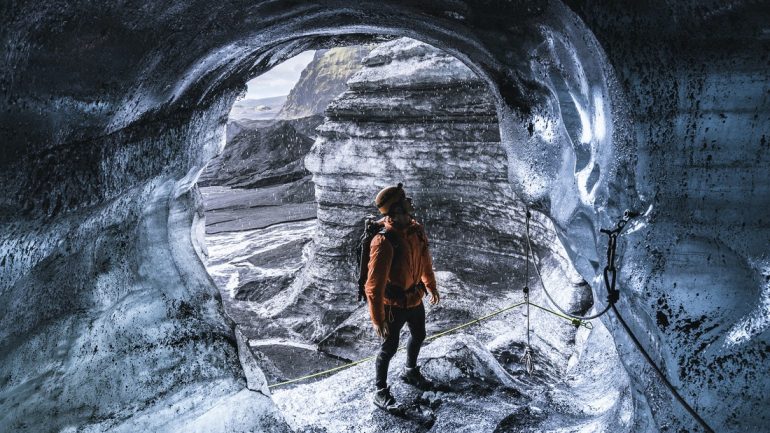
Until fairly recently, visiting an ice cave was an activity exclusive to winter visitors to this country. This is because the caves in Vatnajökull Glacier would flood with the rising sun, making them inaccessible from spring onwards. However, a few years ago, glacier explorers found caves in Mýrdalsjökull Glacier that didn’t melt in the spring, opening up this activity for visitors year-round.
These caves were named Katla Ice Caves, as Mýrdalsjökull Glacier covers the active Katla Volcano. Inside, you’ll find a magnificent combination of colours of bright blue ice mixed with black ash from past volcanic eruptions.
Summary
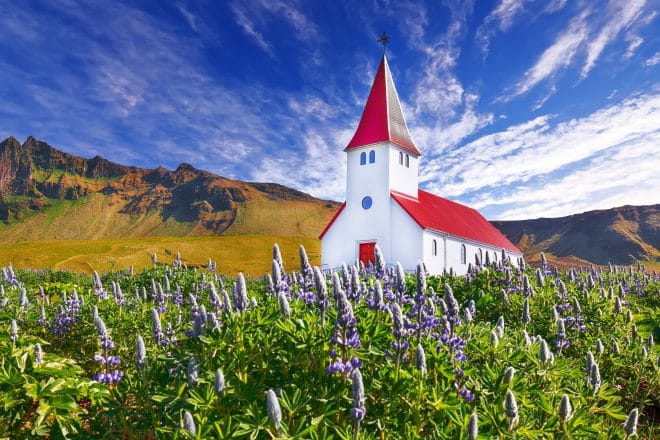
Summer in Iceland is perhaps the best time to visit the country. Unlike the rest of Europe, the weather here stays mild, providing visitors with a welcome break from the scorching heat.
The night doesn’t get dark in the summer thanks to the midnight sun, so when visiting, remember a sleep mask.
Summer activities are plentiful in Iceland, and they include puffin watching, visiting sparsely populated areas, and enjoying beautiful nature.

